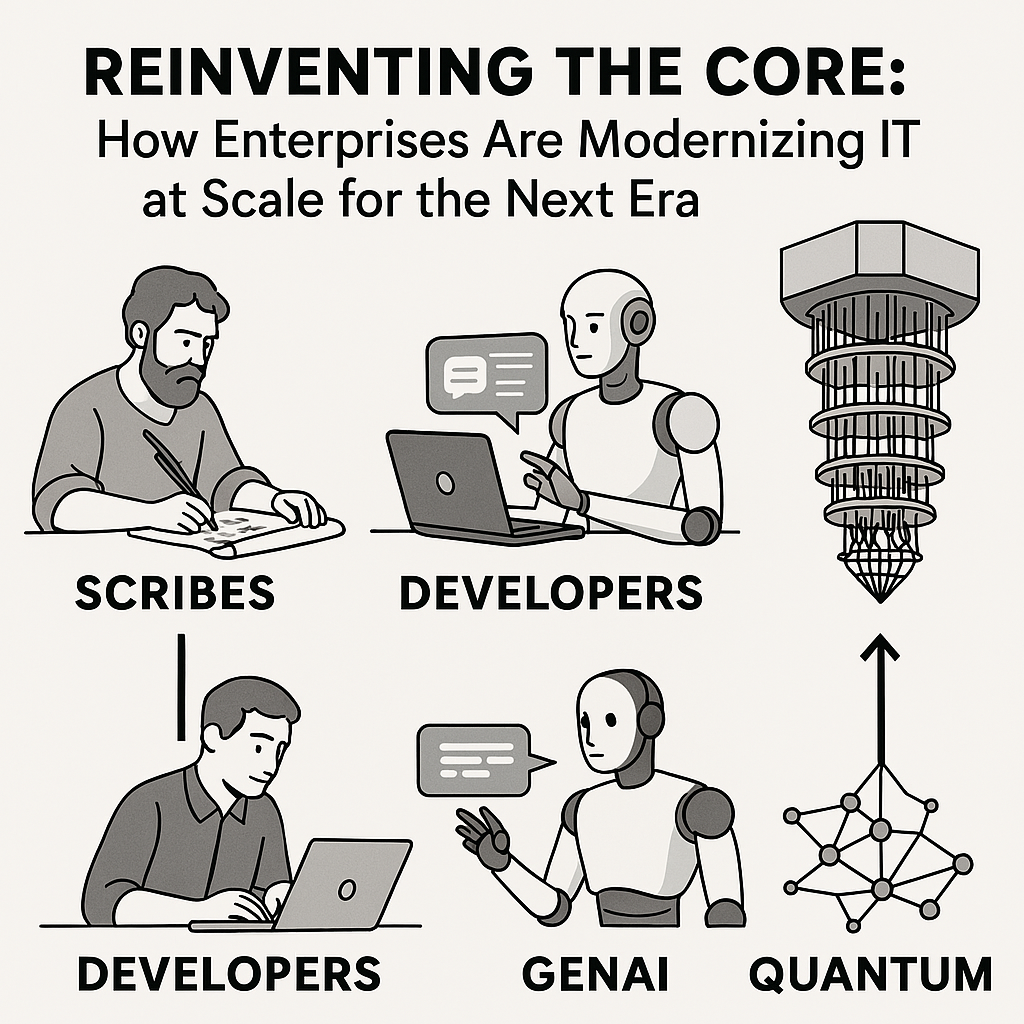Reinventing the Core: How Enterprises Are Modernizing IT at Scale for the Next Era

When Nimesh Mehta, EVP and Chief Information and Strategy Officer at National Life Group, likens decommissioning legacy systems to an archaeological dig, he isn’t exaggerating. For companies with century-old roots, legacy technology is not just outdated code—it’s entangled DNA. And the bigger the enterprise, the more these systems form the foundation of day-to-day operations.
"Some of our systems are older than me," Mehta says candidly. This isn’t just a humorous aside—it underscores the depth of integration legacy platforms hold. National Life has quadrupled in size in recent years. But its systems weren't built for such scale. So, starting in 2017, they began what would become a continuous, evolving journey to overhaul more than 100 mission-critical systems.
This wasn’t a single transformation. It was a cascade of them.
Legacy modernization, at this scale, is not just a technology refresh. It's an organizational shift. One that demands new thinking, new roles, and often, a shift in culture. And perhaps most importantly, a shift in how IT and the business interact—not as support functions and stakeholders, but as strategic partners.
Legacy platforms are deeply embedded because they work—or at least, they once did. They touch everything: underwriting systems, policy issuance, claims, CRM, billing, finance. And often, no one alive in the organization today remembers exactly how or why certain things were built.
This is why decommissioning can feel like disarming a bomb blindfolded.
At Ulta Beauty, the drive toward modernization wasn’t just about performance—it was about agility. Chief Technology and Transformation Officer Mike Maresca realized that to remain the leader in beauty retail, Ulta had to think beyond retail.
It wasn’t just about upgrading SAP ECC to S/4HANA. It was about aligning technology with how consumers now buy—on mobile, online, across channels. It was about enabling real-time inventory, automated finance, and mobile tools for associates. And it was about eliminating over 10 legacy apps that created operational drag.
The catch? It had to be done without disrupting the experience across 1,400+ stores, eCommerce channels, and back-office functions. This demanded orchestration at scale—and cross-functional collaboration like never before.
Meanwhile at BetaNXT, Don Henderson inherited a Frankenstein stack built by private equity mergers: multiple platforms, hundreds of Linux servers, and 15+ years of historical data. His mission? Consolidate, modernize, and migrate all of it to the cloud.
To do that, Henderson and team obsessively simulated, parallel tested, and migrated data structures before pulling the plug on legacy servers—an approach that avoided disaster but demanded grueling coordination.
Here’s what many transformation efforts miss: decommissioning isn’t just expensive in money—it’s expensive in knowledge.
Legacy systems often have no documentation. The engineers who built or understand them? Retired. Or gone. National Life had to bring some of them back from retirement to help decompose the systems. It was less about clean code and more about unearthing hidden dependencies.
You don’t know what you don’t know until you start breaking things.
This is why Mehta describes the process as uncovering a buried city and building a new one on top—without collapsing the old foundation.
Even after you migrate, legacy systems don’t just vanish. They need to be actively decommissioned. That’s time, resources, and planning many companies underestimate.
Ulta, for instance, had to integrate 17 new applications, sync with over 30 systems, and maintain continuity across every digital and physical storefront—all while maintaining daily operations.
The advice from these leaders? Treat decommissioning as a program within modernization—not a line item at the end.
Every enterprise can purchase S/4HANA, AWS, Salesforce, or Snowflake. But what determines transformation success isn’t tech. It’s culture.
National Life redefined its processes before redesigning systems. They didn’t modernize for modernization’s sake. They visualized what their business needed to become—and then engineered toward that vision.
That kind of future-first thinking means giving up nostalgia. It means breaking attachment to systems people have spent years, sometimes decades, building. And it requires executive buy-in, not just funding but emotional support.
Ulta’s Project SOAR is a textbook case in managing change. The rollout involved workshops, communication campaigns, and training across every store and business unit. Transparency, updates, and continuous feedback loops created a narrative of progress—not upheaval.
Modernization must be accompanied by modernization of mindset.
All three enterprises put a spotlight on the same principle: clean the data before you modernize the stack.
If you move bad data to new systems, you’re not transforming—you’re transferring technical debt.
National Life spent significant effort rationalizing legacy data before building Lego-like services to replace monolithic systems. They knew that without clean, integrated, well-tagged data, microservices would have nothing to plug into.
BetaNXT faced this too, with multitenant structures from the early 2000s that followed no standards. Henderson’s team had to manually test and remediate data across platforms before confident migration.
Data readiness is the unsung hero of modernization.
Ulta Beauty is already seeing a 30% reduction in manual processes and thousands of hours saved annually. They’ve positioned their operations to support new categories, channels, and geographies—at scale.
National Life has transformed from a development-heavy IT team to an integration powerhouse, leveraging modularity and composability to accelerate go-to-market initiatives.
BetaNXT is saving millions by shutting down data centers and cutting capital outlay for hardware refreshes. The ROI is not just financial—it’s strategic. They’ve built a foundation for agility.
What these modernization efforts reflect is a shift in how work itself is being executed. It’s no longer about building monolithic internal IT teams or giant outsourced contracts.
The new model is Virtual Delivery Centers (VDCs):
Modular teams that execute specific transformation sprints.
Globally distributed but centrally coordinated.
Focused on integration, not just development.
Activated on demand, sunset after success.
In a world where the tech stack changes every 5 years, the workforce model must evolve too. Enterprises that embrace VDCs gain flexibility, cost control, and access to top talent globally—without building new legacy in the process.
Every company in this story has one thing in common: they didn’t wait for perfect conditions.
They started.
They broke down monoliths.
They cleaned up data.
They engaged the business.
They accepted the pain.
And they built for a future they could barely predict.
The era of centralized, monolithic IT systems is ending. In its place, a new, modular, networked enterprise is emerging. Whether you're a 176-year-old insurer, a national beauty retailer, or a fintech infrastructure company, the path forward is the same:
Modernize, modularize, and virtualize.
Or risk becoming the legacy everyone else is trying to forget.

For modern telecom enterprises, delivering exceptional QoS is no longer optional—it’s a brand differentiator and a strategic lever for growth. Static provisioning models won’t cut it in a world of hyper-dynamic data usage.